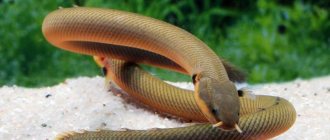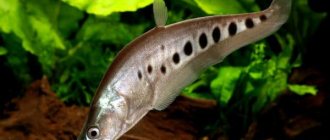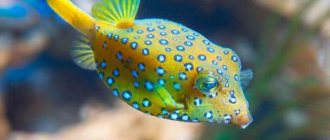Almost every amateur aquarist strives to diversify the composition of the inhabitants of his aquarium. Sometimes you just want something exotic!
We present to your attention fish with a snake-like body shape that are completely different in character and temperament. They are united only by a similar structure, a preference for the twilight time of day over the daytime, and the need for a sufficient number of shelters in the aquarium. Any of these fish may be suitable for a certain biotope: among them you can choose a resident for a peaceful, community aquarium, or for a mono-species aquarium, or for company with predators. Any of them will definitely bring unusualness, exoticism and originality to the home underwater world.
Acanthophthalmus kuhlii
Acantophthalmus Kühl is a favorite of aquarists, a small, bright, active inhabitant of home biotopes. This fish is native to the slow rivers of Southeast Asia. Acantophthalmus has an elongated, round, flexible, snake-like body with a small head. The small lower mouth is surrounded by three pairs of whiskers. Under the barely noticeable eyes are spines that Kühl's acanthophthalmus uses to protect itself from predators. The fish received its second name – prickly eye – thanks to them. The color of the fish is contrasting: there are frequent beige-yellow vertical stripes on a brown background. Acanthopthalmus grow up to 10 cm and feel comfortable in the company of their relatives. These are crepuscular fish, hiding in shelters during the daytime.
Spiny eyes are unpretentious and are suitable for small aquariums from 50 liters with peaceful inhabitants.
Keeping in an aquarium
The minimum volume of an aquarium for a pair of calamoichts is 100 liters. If you plan to make a species pond with several individuals, then take a container of 250 liters or more.
A must-have piece of equipment is a tight-fitting lid..
In addition to the fact that the snake fish calmly jumps out of the water, it, thanks to the flexibility of its body, easily slips into small holes.
The habitable bottom of an aquarium with Calabarians is the attic of an old house: the more “cluttered” it is with decorations and plants, the better for the fish .
All kinds of shelters and dense thickets allow them to feel safe, especially during the daytime.
Water parameters
When equipping an aquarium, a good filter is required , but a compressor for Calabarians, with their ability to breathe with their lungs, is irrelevant. It will only be needed if the reservoir contains fish of other species.
In terms of water parameters, we adhere to the following indicators:
- temperature - 25...27 °C;
- acidity - 6.5–8 pH;
- hardness - 5–19 gH.
Every week it is necessary to replace 20–30% of the water volume.
Content nuances
The snake fish spends the active part of its life at dusk, so lighting parameters do not play a special role for it .
If you want to see how it warms up on the filter, install a low-power incandescent light bulb.
Plants, of which there should be a lot in the aquarium, need more light: Calabarians like to hide in thickets.
However, floating plant species are undesirable. If you want to use them, you will have to carefully control the growth process.
Lungfishes often rise above the water and breathe clean air . If they are unable to gasp for air, they will die from suffocation because breathing through their gills does not cover their oxygen needs.
View this post on Instagram
Posted by Anastasia (@aquarium_for_the_soul) Apr 18, 2021 at 5:06 am PDT
Macrognathus aculeatus
Macrognatus ocellata is a fish from the proboscis family, found naturally in the waters of Southeast Asia. Macrognathus has an elongated, laterally compressed, strong body. Quite large eyes are located on the pointed head, the upper jaw is elongated and resembles a proboscis, a sensitive organ that helps in searching for food. The color of the macrognathus is brown with a light pattern; the rear part of the body is decorated with contrasting eye spots, thanks to which the fish received its name. Macrognathus grow up to 40 cm and need large-volume aquariums (from 250-300 liters). They are loners. These fish perceive small neighbors as food. With macrognathus, you should keep active, proportionate, but not aggressive fish. They lead a twilight lifestyle, hiding in shelters during the day.
Diseases
In general, dragon fish have a strong immune system. You should pay special attention to newly purchased fish: for prevention purposes, it is better to carry out quarantine: place the fish in a special tank for 1-2 weeks and monitor their skin and behavior.
Calamoichtas almost never become infected with fungal and parasitic infections. If this happens, it is important to remember that standard treatment measures are not suitable: these fish cannot tolerate salted water, formaldehyde, or natural dyes.
Major health problems arise from dirty water. Exceeding the level of nitrates and nitrites immediately affects the well-being of calamoikhts: they begin to worry and swim to the surface too often for a breath of fresh air. Therefore, it is important to regularly change the water and clean the soil.
Calamoicht (Erpetoichthys calabaricus)
Kalamoicht is perhaps the most “snake-like” fish in the home aquarium, originally from West Africa. Kalamoikht looks very similar to a snake: a long, rounded body, a slightly flattened head, large scales, greenish-brown color. On the head of the kalamoichta there are sensitive outgrowths that serve as organs of touch.
In nature, fish grow up to 90 cm, in captivity they are usually smaller. They require aquariums from 200 liters. Kalamoikhtas are able to live together in a flock. Small fish around them will be perceived as food, but they get along well with mobile, proportionate or “inconvenient to swallow” fish (for example, angelfish).
Kalamoikhts can escape. The aquarium should always be tightly closed!
Feeding
Keeping the Calabarian with other fish requires a special approach to its feeding.
The snake-like exotic is blind, it does not have time to see and grab its portion of food, and therefore often remains hungry.
Experienced owners advise feeding the kalamoicht when all the other inhabitants of the aquarium are full.
The basis of the diet is protein feed; the kalamoicht eats maggots and worms well, and will not refuse pieces of chicken or fish fillet .
Juveniles are fed 5–6 times a week; adult fish are fed 2–3 times a week. Intervals in feeding are necessary for complete digestion of food.
Polypterus senegalus
Polypterus sinegala is a powerful fish from the multifinned family.
It belongs to the oldest fish, whose ancestors lived on the planet many millions of years ago. Polypterus has a long, round body with a flattened head resembling a snake's and a dorsal fin resembling a dragon's crest. The pectoral fins have turned into a kind of “legs” that allow the fish to stay on the bottom or crawl from one body of water to another. The color of Sinegalese Politperus is light brown, the fish grow up to half a meter in the wild, and about 30 cm at home. Polypterus are suitable for a large aquarium of 300 liters or more with a good filtration system (they eat a lot and excrete a lot of waste products) and a tight-fitting lid (fish prone to escape!). Decorations in the aquarium must be securely fixed to avoid injury to polypterus. Among their neighbors, large cichlids (acaras, parrots) or other sized fish (pacu, pangasius) may be suitable for them.
Systematic position and origin
The scientific name of the aquarium snake fish is Calamoichthys Calabarius. Despite this, due to the external features of the underwater inhabitant, it is often called a rope or rope. Kalamoicht calabar belongs to the class of ray-finned fish, the order of multi-finned fish and the family of multi-finned fish.
Watching the body movements of a snake-like fish is a pleasure, because by its nature the swimming of this representative of chordates is somewhat reminiscent of mythical water dragons.
In its natural environment, the “aquarium snake” lives in the waters of West Africa, hiding in the thickets, so another name for kalamoichta is reed fish.
When in an aquarium, the serpentine underwater inhabitant prefers secluded places, where it curls up into a ring and becomes quiet.
Common loach (Misgurnus fossilis)
The common loach is a peaceful, non-conflict, unusual fish native to the reservoirs of Europe and Asia. Loaches have a long, round body covered with small scales. The mouth is “lower”, it is bordered by five pairs of sensitive antennae. The color is light brown or sand. Loaches grow up to 30 cm. These fish are very unpretentious and can be kept in a school both in an aquarium and in a garden pond. They live mainly at the bottom. More active in the evening. Loaches are suitable for community aquariums with peaceful fish.
How do snake fish reproduce?
It is easy to identify a male ready for mating - his anal fin begins to swell and thicken. And if a couple swims in parallel, then offspring can be expected soon. The female lays eggs on the male's subcaudal fin, and he, in turn, fertilizes them. After this, the eggs settle on the ground and stick firmly to it. This process consists of several stages and lasts until all future offspring are at the bottom.
After 3 days, the larvae appear, and within 3 weeks they hang from the substrate. After 3 weeks, complete resorption of the embryonic organ occurs, and babies emerge, able to swim and eat food without assistance.
Snake fish are unusual pets that arouse interest with their unusual appearance, habits and behavior. They are an adornment to any collection - demanding, original, unique.
Mastacembelus armatus
Mastacembelus armored is another representative of the proboscis family, similar in appearance to macrognathus, but has a more aggressive character and grows up to 90 cm. The homeland of Mastacembelus is the reservoirs of Asia. The fish has an elastic, long body, slightly compressed from the sides. The upper jaw also ends in a sensitive proboscis. The fish got its name “shell” for its specific color: on the dark body there are lighter brown spots, reminiscent of a turtle shell.
Mastacembelus is an ambush predator, tasting everything that fits into its mouth. Adults should be kept alone; they are aggressive and territorial towards their relatives. Mastacembelus look unusual and exotic in large aquariums and show aquariums. Among their neighbors, large, agile fish are suitable.
Compatibility
When choosing neighbors for the calamoichta, compare the size of the new inhabitant with the oral cavity of the calabar: if the snake cannot swallow it, you can safely move it in .
Snake fish have good compatibility with cichlids, angelfish, catfish, and tilapia. A predator itself, it does not claim territory and becomes active as night approaches, when the other inhabitants are sleeping.
Calabarians are not housed together with small neons, guppies, shrimp and crustaceans . Having gone out hunting at night, the “snakes” will not fail to feast on them.
Important! The number of males and females should be the same. If there are more males, the extra ones will die in fights.
Freshwater moray (Gymnothorax tile)
The freshwater moray eel is a very unusual pet for the home aquarium. In nature, it lives in brackish river estuaries in India and Indonesia. This fish has a long, rounded body with a narrowed muzzle, skin without scales, and covered with protective mucus. The color of the fish is brownish or grayish. Moray eels grow up to 60 cm. These are typical ambush predators. Adults should be kept alone due to their territoriality. Moray eels live well in completely fresh water, but adding salt to 5 ppm improves the quality of life of these fish. Among their neighbors, moving, not small fish, such as argus, monodactyls, will join them in company - they also react positively to low salinity of water. The required volume of an aquarium for moray eels is from 200-300 liters. The lid must always be closed!
Habitat
Africa - inhabits small, slow-flowing rivers and stagnant bodies of water. Widely distributed in West Africa, caught in the Democratic Republic of the Congo, Angola, Nigeria, Cameroon, Equatorial Guinea, Benin. As a rule, it lives in shallow waters, in waters with dense vegetation.
Lepidosiren paradoxa "Gold")
Lepidosiren - or American scalefish, is a very unusual lungfish native to the reservoirs of America. Its peculiarity is the ability to breathe oxygen in the air and hibernate during the dry season. Lepidosirens grow over 1 meter and are a decoration for show aquariums! They have a long, powerful, rounded body covered with mucus instead of scales. The pectoral and anal fins have the form of cords. The eyes are very small and inconspicuous. The color of the fish is gray-brown, with yellow spots present in young individuals.
Despite its exoticism, lepidosiren is quite unpretentious. Among its neighbors it prefers the company of calm, large, non-aggressive fish. Can be combined with angelfish, discus, and stingrays.
General information
Ampularia are a group of the most common and popular aquarium snails. They are distinguished by their bright colors, unpretentiousness in maintenance and are useful in the aquarium, eating food left over from the fish, as well as cleaning the walls of algae.
Currently, the most commonly found species of apple apples are Pomacea bridgesi, Pomacea maculata, Pomacea canaliculata and Pomacea paludosa. In English-speaking countries, the apple snail is called “Snail-Apple”. Gastropods received this interesting name due to the similarity of the color of the rounded shell with some varieties of apples.
The homeland of ampularia is South America. In 1904, the first specimens were delivered to Germany, and a few years later they were widely distributed among aquarists around the world.
Ampullaria are large snails; some specimens can grow up to 10 cm. In nature, they have adapted to life in bodies of water with low oxygen concentrations. These mollusks have adapted to breathing both oxygen dissolved in water and atmospheric air, for which they periodically stick out of the water a long breathing tube - a siphon. Its length can reach 12 cm. This feature allows the snails to stock up on oxygen with minimal risk of being eaten by a predator.
It is important to remember that even despite the presence of gills, ampullaria periodically need to breathe atmospheric air, otherwise the snail will quickly die. In aquariums, this can occur when mollusks are kept with large or active fish, which prevent the ampularia from crawling to the surface. Ampoules periodically need a “sip” of atmospheric air
Ampoules periodically need a “sip” of atmospheric air
Finally, another important survival device is the cover of the mouth of the shell. This is a dark horny plate that the mollusk is able to tightly close. The ampoule can remain in this position in a humid environment for quite a long time until conditions return to normal. In an aquarium, this behavior, of course, is not observed. The cover also protects well from enemies.
Ampularia's ability to regenerate is amazing. A bitten organ usually recovers within a month.
Some people are afraid to get apple apples after learning that in nature this species is an intermediate host for some roundworms. It is worth noting that snails bred at home simply cannot have such a parasite, because contact with the main carriers – wild rats – is excluded. And in order to become infected, you still need to eat a raw snail.
You can often hear unusual stories that ampullaria are able to hunt fish and eat them. But these are just legends. A leisurely and overweight snail is hardly able to catch up or grab a fish swimming by. Most likely, such stories are based on the fact that ampularia can often be found on dead fish in an aquarium. However, ampullaria feed on the dead remains of already dead fish; these mollusks do not hunt.
Freshwater pipefish (Microphis brachyurus)
The freshwater pipefish is a wonderful, delicate fish that is not often found in home aquariums. It comes from the reservoirs of India, Japan, and Madagascar. The needle has a thin, elegant, long body; on the head there is an elongated snout, adapted for sucking food. The color is not bright, sandy brown. Freshwater needles grow about 20 cm. An aquarium of 80 liters or more is suitable for them. A prerequisite for keeping these unusual fish is the presence of a large number of living plants in the aquarium - a comfortable environment for a quality life. Needles are timid and fearful creatures. It is recommended to keep them in a mono-species aquarium, or with equally calm, non-aggressive fish.
Neighborhood
Usually this is not a problem. It is enough to take into account a couple of nuances and then the pets will easily get along in one aquarium:
- They are not suitable for large aggressive cichlids. They may think that the kalamoicht is a large worm and can be eaten. In principle, you can plant cichlids, but those that do not grow too large. For example, the same cichlazomas, yellow, etc.;
- Neighbors shouldn't be too small. Such that they can get into the mouth of a snake fish. That is, various neons, rhodostomuses, guppies and other similar species are not suitable. Even small barbs can be used for feeding.
Kalamoicht gets along well with Acantophthalmus.
The best neighbors are synodontis, corydoras catfish, botia, angelfish, etc. As a rule, the snake fish does not show any attention to them.
Red snakehead (Channa micropeltes)
The red snakehead is a colorful predator native to the waters of Asia. The snakehead has a long (up to 1 meter) powerful body. The flattened head has large, round eyes and a capacious mouth. An attractive sandy coloration with red and black horizontal stripes is characteristic only of juveniles; adult fish are more modestly colored, gray-black. Snakeheads can be kept in a flock until a certain age. Sexually mature fish become aggressive towards their relatives. An aquarium of 500 liters or more with free space for swimming and shelters is suitable for them. The lid of such an aquarium must be tightly closed! Of the neighbors with the red snakehead, comparable pacu, pangasius and other fish can get along.
© Aqua Logo Evgeniya Stepanova
Fields marked with * are required.
Breeding
Snake fish produce offspring quite rarely. After all, most of them are delivered to places of sale from their natural habitats. In nature, their sexual maturity occurs only at 2-3 years of age. During one spawning they can spawn up to 100 thousand eggs. Both parents protect them. In addition, they wave their fins to saturate the eggs with oxygen.











